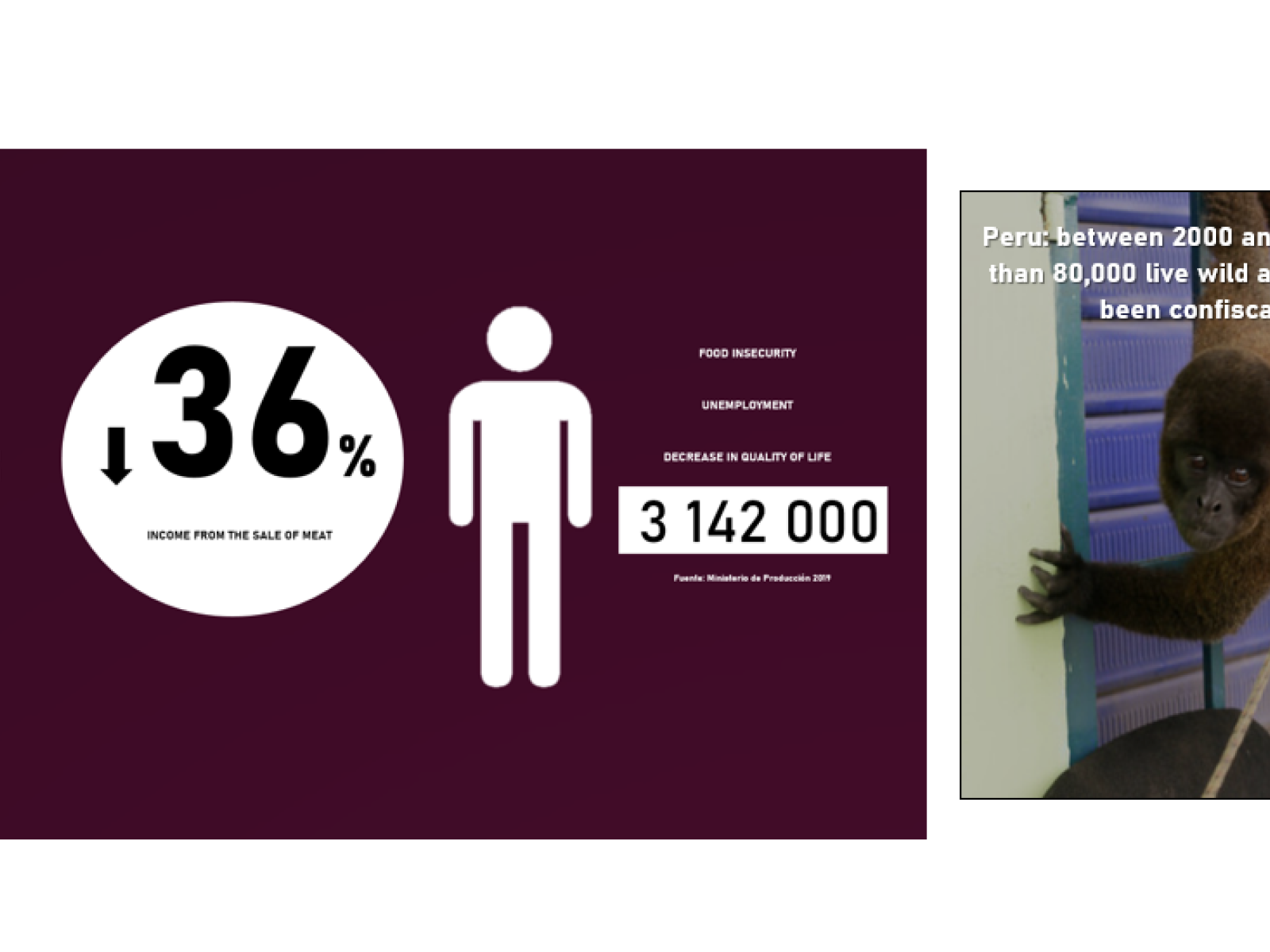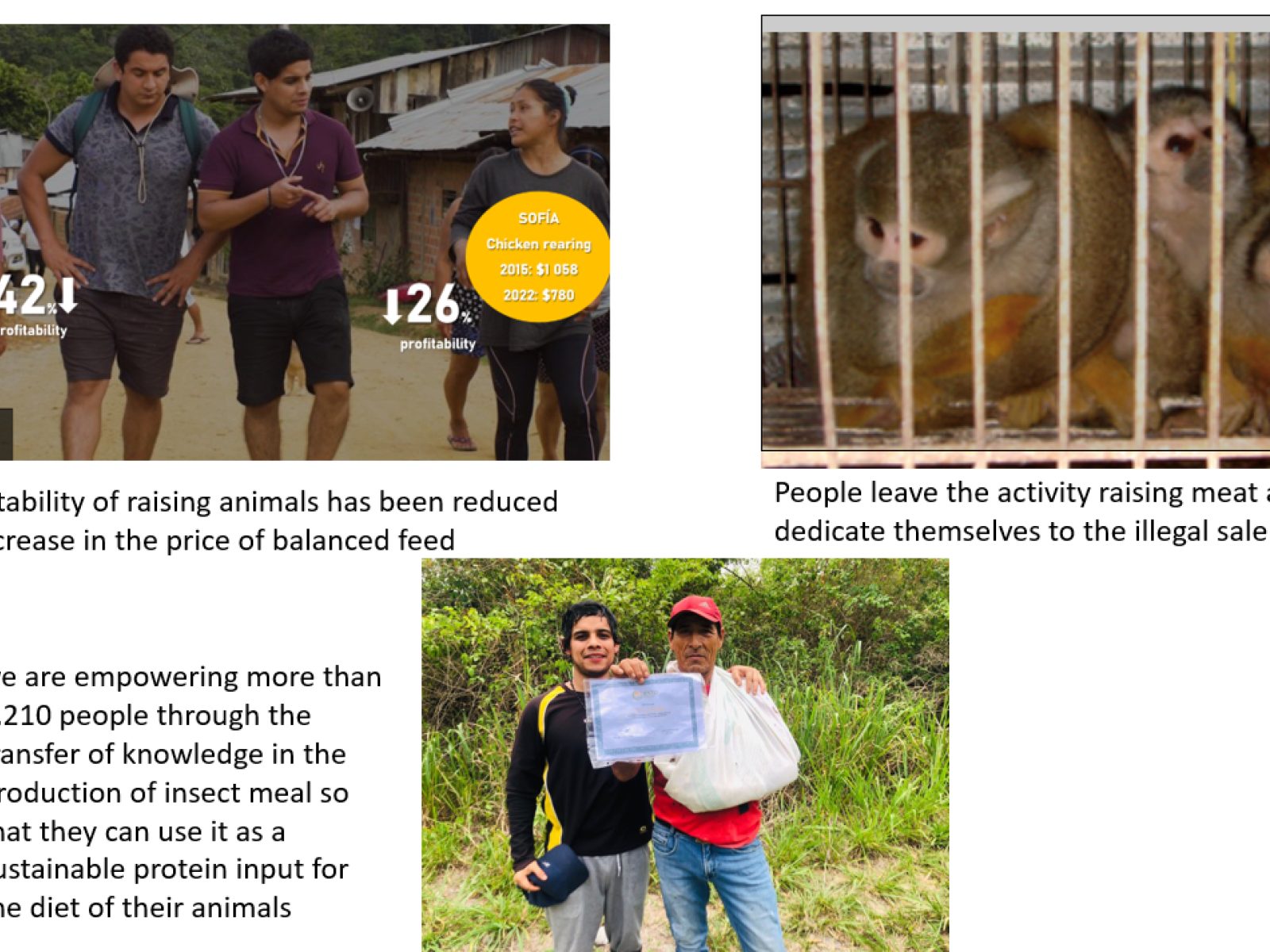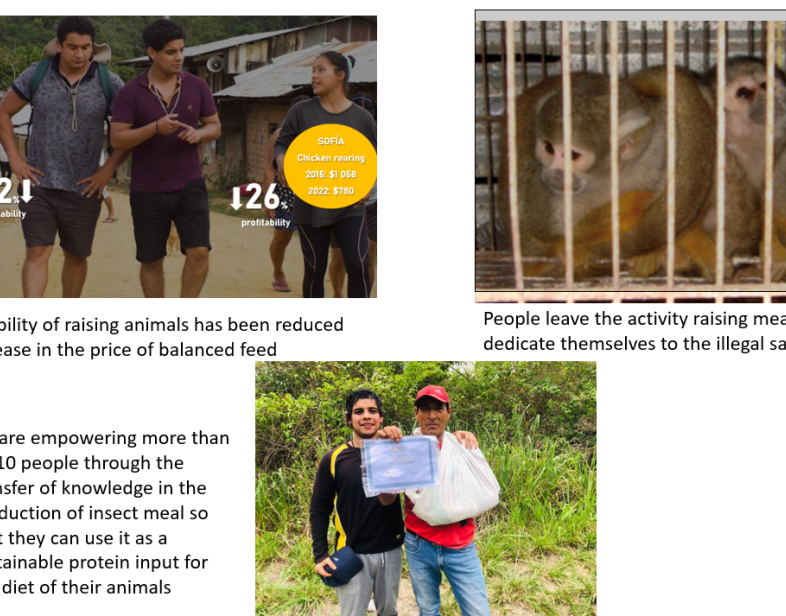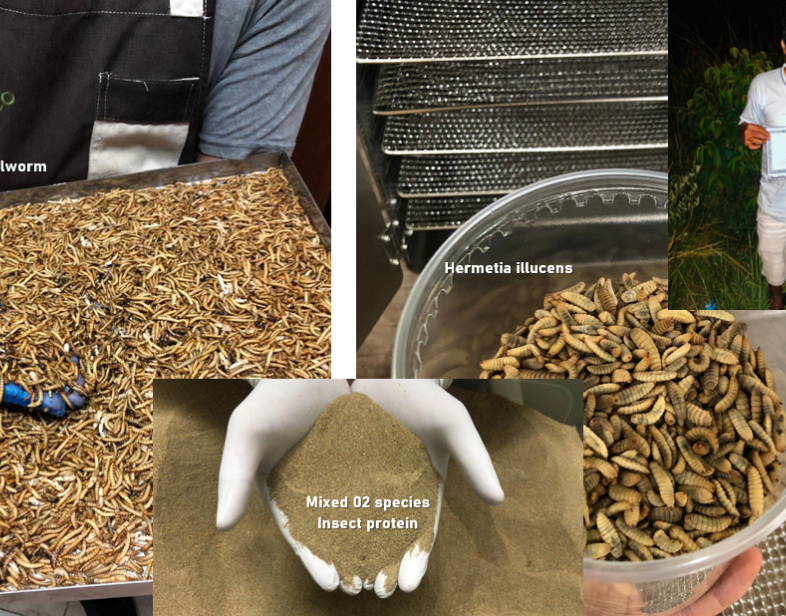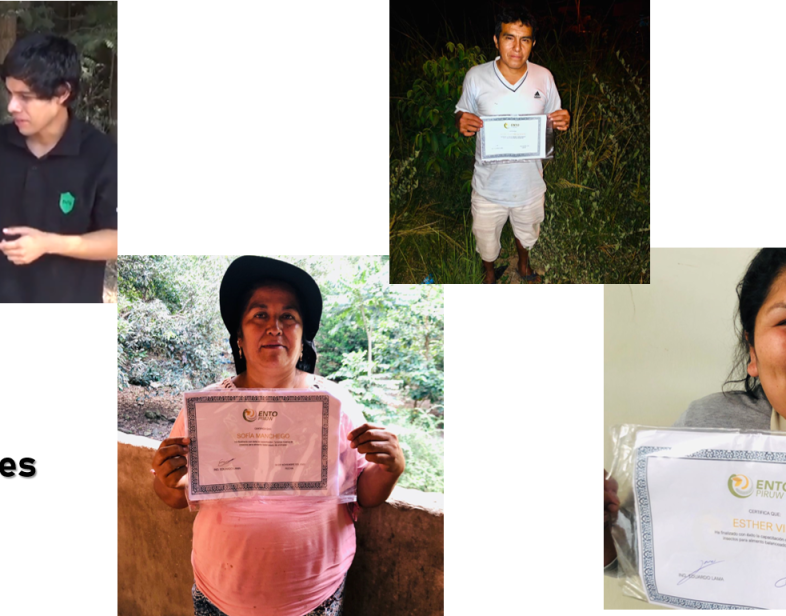An Overview Of Our Solution
PROBLEM: The price of balanced animal feed has tripled. This variability in production costs causes more than 2,213,506 families dedicated to raising animals to lose profitability and leave their work, resulting in food insecurity and unemployment. Upon abandoning their previous employment, a high number of people in the country's jungle venture into illegal unsustainable animal trafficking and coca cultivation.
SOLUTION: At Ento Piruw we are empowering more than 1,210 people through the transfer of knowledge in the production of insect meal so that they can use it as a sustainable protein input for the diet of their animals, thereby increasing their profitability and promoting food security for the communities. Our insect breeding methodologies have been created since 2015 and validated by MIT, FAO, WFP.
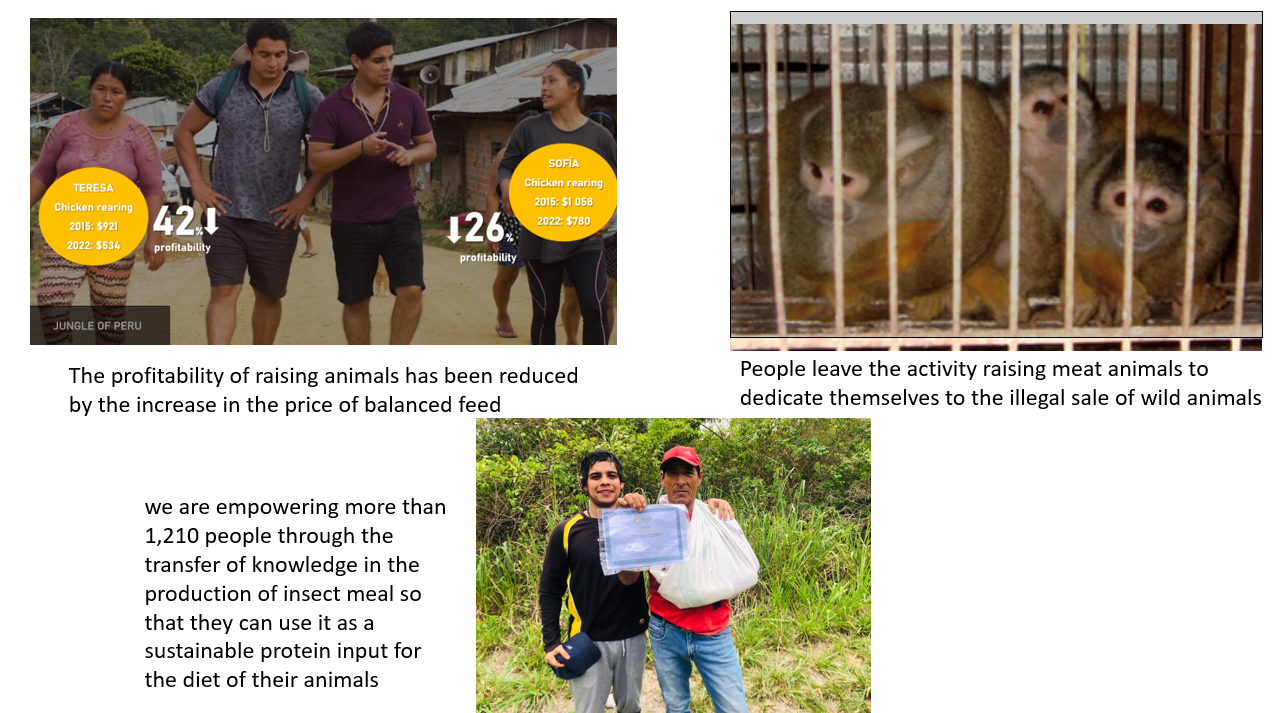
- Population Impacted: 1210
- Continent: South America
First name
Last name
Organization type
Email Address
Context Analysis
In Peru, illegal activity represents US$500 million annually, according to the Ministry of Production. Likewise, between 2000 and 2018, more than 80,000 live wild animals have been confiscated, mainly from the Amazon and the high Andean zone. We operate in the jungle of Peru and we know the reality up close, and we have testimony from people who are dedicated to the sale of illegal animals, many of them were previously dedicated to raising animals for consumption and sale in markets such as chicken. , beef, fish and pork; However, currently the protein source considered the main animal diet called fishmeal has increased its price from 469.3 dollars per ton in 1980 to 1640.5 dollars per ton in 2022. This is because this input is depredated from the Peruvian sea ( with a decrease of 54% of the fish used for fishmeal). To exemplify the problem I will mention the case of two clients and friends. Rafael has been a poultry producer for more than 20 years in Pucallpa (Ucayali in the Peruvian jungle), he longs for his beginnings because the low cost of his inputs for raising his broilers allowed him to have high profit margins. At the same time, Teodoro is a fish farmer in Iquitos (Peruvian jungle). It is estimated that in a few years aquaculture will bring 1 out of every 2 fish that we consume to our table due to the unsustainability of fishing. At the same time, Teodoro is an aquaculture farmer in Iquitos (Loreto in the Peruvian jungle). It is estimated that in a few years aquaculture will bring 1 out of every 2 fish that we consume to our table due to the unsustainability of maritime trawling, and in Peru by 2025 it will have a market size of 760 million dollars. Teodoro was fed up because the price of balanced feed for his fish had tripled, thus drastically decreasing his profitability.
Like Teodoro and Rafael, this reality makes them could make bad decisions.
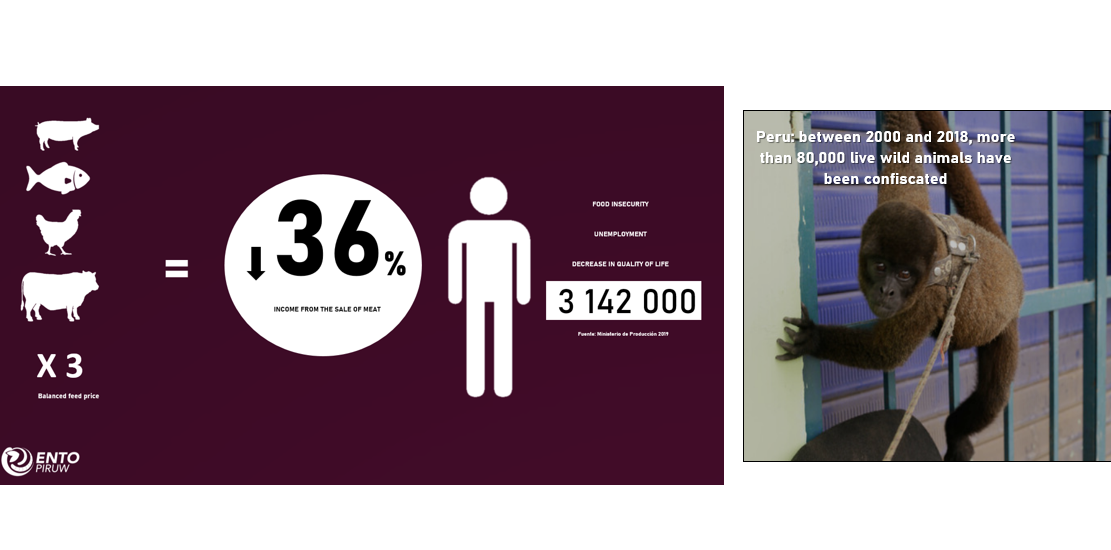
Describe the technical solution you wanted the target audience to adopt
The solution mix the active work of members of the jungle communities where we want to prevent them from getting involved in illegal animal trafficking. We teach them a procedure where science, biotechnology and methodologies created by our company Ento Piruw are applied. For example, using 1 ton of organic waste, 300 kg of insect meal is obtained through bioconversion. Our process was awarded by MIT (massachusetts institute of technology) we obtain more insect protein in less time, without generating unsustainability because we do not depredate the environment, because the insects we use are bred in a manner and we also offer better productivity to the animal breeder where we managed to reach commercial sizes in less time. As part of our team we have zootechnicians who teach them how to formulate diets with insect protein for their chickens, pigs, cattle and fish. Our work has been awarded by the WPF, FAO and the Peruvian government.
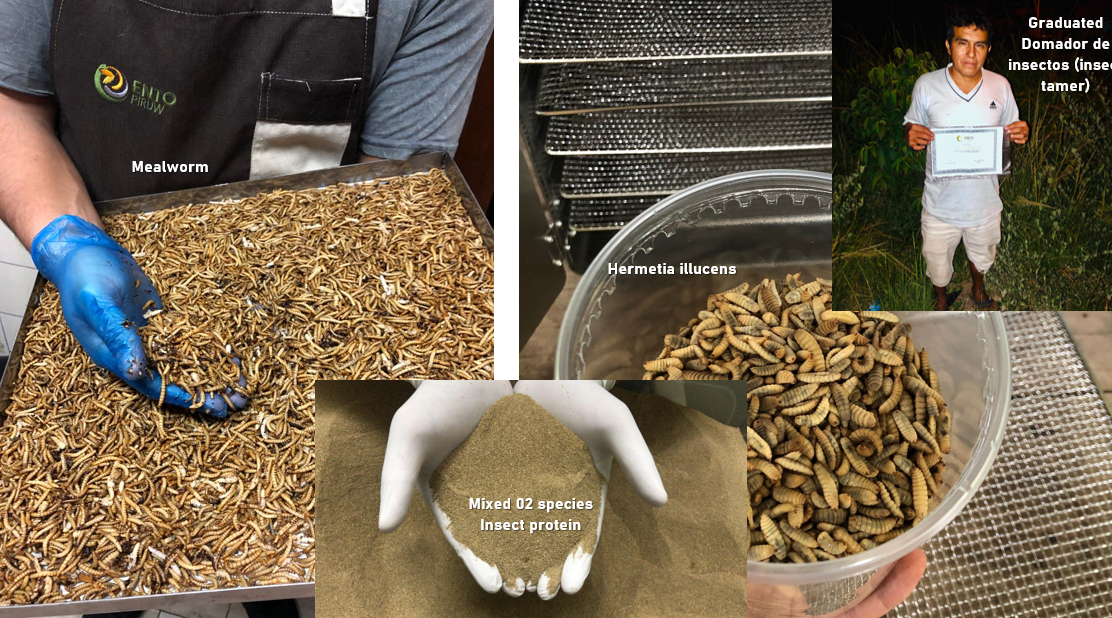
Describe your behavioral intervention.
There are two types of people we have impacted: the first are people who are still raising animals, but are thinking of abandoning the activity due to low profitability, and the second are people who are unemployed or in some way involved in animal trafficking.
The structure of the intervention begins with the context to show the benefits and the goals that can be achieved, as well as the direct consequences that it has with economic income and the environment. The talk is complemented with the guidelines and criminal consequences that the illegal sale of fauna and flora brings with information provided by SERFOR. Subsequently, on average, 95% of the attendees remain in the sessions where theoretical and practical knowledge is transferred to them for the generation of insect protein to feed their animals, we call this group the ; Insect tamers. Then, depending on what type of animal they raise, our participants receive advice to learn how to formulate the diet of their animals with insect protein.
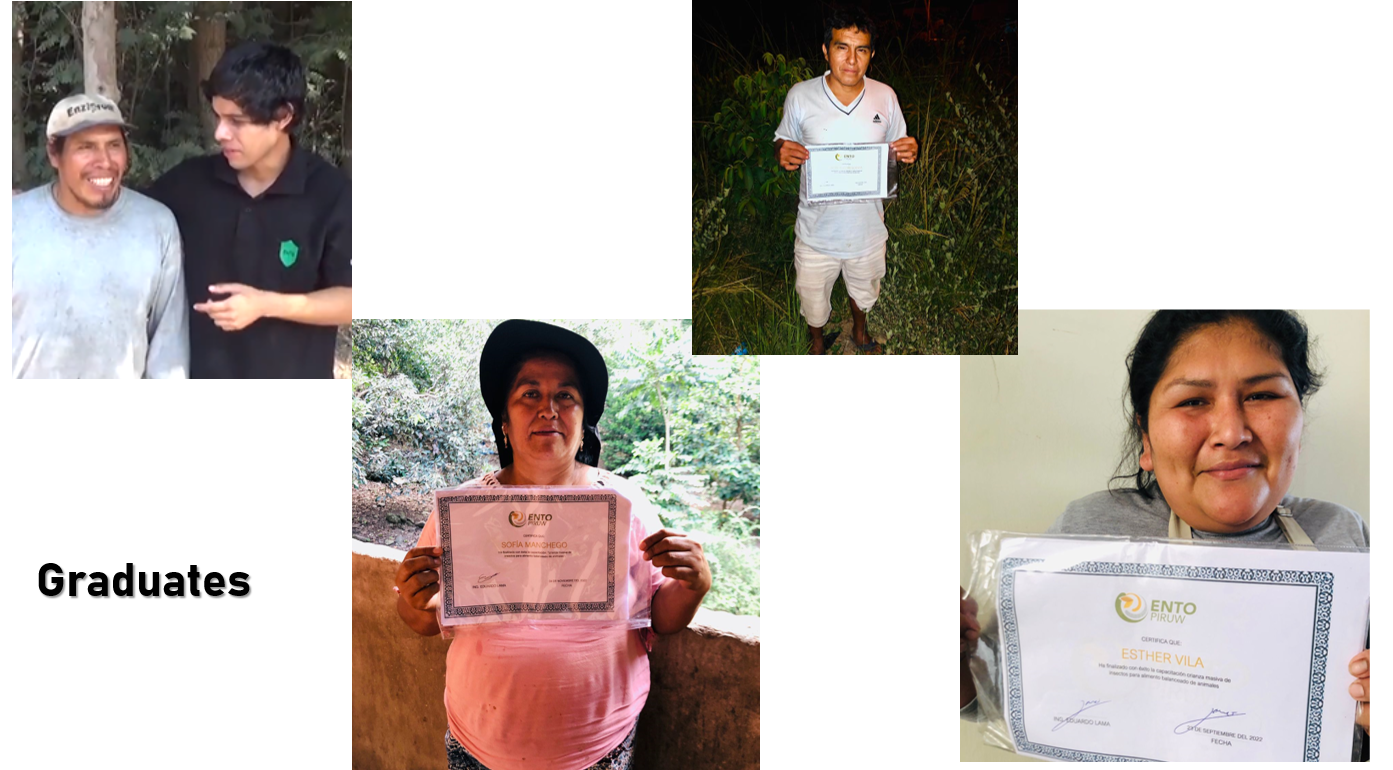
Behavioral Levers Utilized
As needed, please explain how you utilized the lever(s) in more detail.
Within the behavioral levers we use information with our intervention methodology, because the attendees are progressively taught at all times through workshops the step by step necessary for the production of insect protein for animal feed. Attendees are given an emphasis on knowledge and information related to entomology and nutrition. Behavior lever, referring to laws and regulations because with the help of information provided by SERFOR we can disseminate about the deprivation of liberty penalties that carry out illegal work such as the sale of flora and fauna. The incentive lever, when the workshops culminate, the person will be able to reduce their production costs, thus obtaining greater profits from the sale of the meat of their animals. The emotional lever focuses on the autonomy that people have to prepare inputs for their animals' food.
Describe your implementation
- We contact the community, the municipality or a related person.
- Preferably we decided to summon at least 10 participants in order to be more efficient in time.
- We offer insect protein production workshops.
- Optionally we offer workshops on the formulation of balanced food with insect protein.
- Our graduates receive their certificate as Insect Tamers.
- Graduates implement parenting in their respective fields.
- We follow up with the graduates, to provide them with some technical scope in the face of any doubt that may arise during the execution.
Describe the leadership for your solution. Who is leading the implementation?
Eduardo Lama Segura (31 years old): Agronomist. Major reference in Peru in sources of protein from insects, with extensive experience in mass rearing. Named as a food hero by the FAO and recognized by the world food program when they chose Ento Piruw as one of the most important initiatives in Latin America to end hunger, his website is: www.eduardolama.com. He was the creator of the first Peruvian brand that uses insect protein in Peru, Demolitor; and founder of Ento Piruw
Raisa Lama (33 years old): Engineer. Master. Specialist in formulation of balanced food for animals. Analyzes the safety, nutritional aspect of insect meal and its ability to produce feed for fish, pigs, birds, among others.
Renzo Cateriano (27 years old): Industrial Engineer. Specialist in the process of transforming fresh insects into high-quality protein, suitable for incorporating into animal diets.
Share some of the key partners or stakeholders engaged in your solution development and implementation.
We are backed by the United States embassy in Peru that gave us a scholarship for an internship in Silicon Valley to internalize learning and corporate management models that are considered an example, the Massachusetts Institute of Technology (MIT) from the recognition gave us a network of contacts to reinforce some schemes related to biotechnology, FAO, based on the recognition that it gave us as food heroes, we were able to have a diffusion that helps us find more necessary actors, as well as more people with the need that we fight, the The Zero Hunger Commission of the Peruvian government has connected us through events with the presidents of Ollitas Comunes and other people where initiatives can be applied, such as the ones we execute in food security and the Universidad Nacional Agraria La Molina, considered the leading university in Peru in environmental sciences. , it gives us its full support with a framework agreement that allows us to continue ar with professionals, teachers and the media that allows us to reach more people.
Who adopted the desired behavior(s) and to what degree? Include an explanation of how you measured a change in behavior.
Animal breeders such as chickens, pigs, cattle and fish. These breeders live by selling the meat of their animals to markets and supermarkets. These breeders depend on the price of inputs imposed by their suppliers. Many of these breeders are heads of families, whose families depend on the income from the sale of meat to assemble their basic family basket. Nearly half a million direct and indirect jobs (almost two million people depend on poultry farming; on the other hand, in the case of aquaculture, it is the breeding with the highest growth rate worldwide and it is estimated that by 2025 approximately three hundred thousand people in Peru will depend directly and indirectly.
How did you impact the environment (biodiversity conservation, ecosystems, etc.)? Please be specific and include measurement methodology where relevant.
Until today we have been able to prevent approximately 604 cubic meters of water from organic waste from being lost and ending up percolating into groundwater, which can cause serious contamination of connected bodies of water such as rivers, lakes or reservoirs. The way we use water is through the organic waste that contains it. This water becomes a source of hydration for insects that suck it in through their mouths through food or through the insect's skin.
How has your solution impacted equity challenges (including race, ethnicity, social class/income, indigenous communities, or others)?
Regarding the areas of intervention previously, the leader shows us the customs and values, so that during our intervention process we do not generate any conflict and, on the contrary, more people can adopt the massive breeding of insects to feed their animals. Among what we highlight is the use of natural resources in a sustainable manner without altering the environment. The vast majority of the impacted areas are descendants of or belong to Asháninka tribes. Gender equality has been present in equal parts because before our impact, normally the man had the task of obtaining, buying and collecting balanced food for animals, while the wife had the task of feeding and hydrating the animals raised.
What were some social and/or community co-benefits?
Some benefits are the reincorporation of people to agricultural activity.
Increase in food security.
Equitable work, empowerment of indigenous communities.
Self-sufficiency in the production of insect protein.
Self-sufficiency in the production of animal meat.
What were some sustainable development co-benefits?
sustainable development benefits:
Sustainable protein production.
Organic waste recycling.
We avoid loss of CO2 from the decomposition of organic material.
Water recycling.
Generation of employment respectful with the environment.
We avoid illegal mining, sale of wildlife, illegal logging and coca cultivation.
Sustainability: Describe the economic sustainability of your solution.
We have a mechanism of economic self-sustainability based on the sale of protein input, fertilizer, training, however, if we want to scale the social impact to more people, an external source of financing is necessary: Necessary for (I) Labor. (II) Supplies and materials. (III) Machinery and equipment (IV) Tickets and per diems (V) Infrastructure for breeding. (V) Payment of hours.
Return on investment: How much did it cost to implement these activities? How do your results above compare to this investment?
When investing in the transformation of 1 ton of organic waste, the agricultural producer can obtain 300 kg of insect protein and 600 kg of fertilizer that can be used in vegetable production. This source of protein allows a saving of 20% compared to a traditional source where especially the agricultural producer of the jungle feels the consequences of the extra logistics cost for the transport of the traditional protein input that is used for balanced food vs protein meal from insect for meat animal use.
How could we successfully replicate this solution in Latin America?
To scale in more communities we have delimited 5 steps; The first is to access the state entity responsible for the agricultural census, step 2 biotic and abiotic analysis of the potential site, step 3 contact the community leader, step 4 training and technology transfer, monitoring of our graduates through the leader.
We seek to make alliances with different regional governments to more quickly identify poultry and fish farmers who may be having the problem we are fighting. It is planned to establish an insect protein production center in the main livestock areas of the country where trained breeders can become the leaders of their respective production centers in their areas.
Themes Related To Wildlife Trafficking in Peru
Peruvian Regions Applicable
Describe how the technical solution addresses wildlife trafficking in the Peruvian Amazon.
Most of the people who are dedicated to the trafficking of wild animals, before were dedicated to raising animals such as chicken, pork, fish and beef; for the sale of meat. However, the low profitability generated mainly by the increase in balanced feed has brought with it the abandonment of the activity. We offer the solution to the population that has abandoned or will soon abandon agricultural activity, especially in the Ucayali, Loreto, Madre de Dios jungle; because as a solution we offer a self-sustaining and self-sufficient way through the transfer of expert technical knowledge on the production of insect protein in animal breeders; so that they can feed their animals in a sustainable way with the planet and without depending on companies that raise the price of balanced food. The generation of agricultural activity has a positive impact on the food security of the place.
Describe the sustainability and scalability of your technical solution
The sustainability of our process originates from the collection of raw material, as an input organic waste considered losses in the crops (by collecting we prevent water and CO2 from percolating marine bodies or acting as a greenhouse gas respectively), later we feed the larvae of insects who behave as bioconverters. The insects are not extracted from the environment, but we have a solid breeding stock that serves as parents.
If applicable, explain the level of progress of the solution
The solution is currently in the expansion phase, where we have already had successful pilots with a social impact. In the year 2022 we closed with more than 1,210 animal breeders who received the solution, each breeder is mostly the head of the family with an average of 4 people who maintain, that is, an average impact has been achieved on 4,840 people. We estimate that for the year 2025 with the help of this leverage fund we will be able to reach more than 5,247 breeders with an impact as heads of families of 20,988 people.
What are the additional sources of funding for the solution?
It was about the seed financing Bio Challenge of the Ministry of Production of Peru in the year 2017 of s / 50,000; where we position ourselves as the first company that produces insect protein in Peru. Here is the link of the interview that the Ministry of Production did to us; https://www.youtube.com/watch?v=2zYyuwshfsk&t=4s Although the financing was 50 thousand soles; later with a lot of effort we have grown in sales; 2019: s/4016; 2020: s/69,766; 2021: s/ 333 303 ; 2022: s/ 702 915
Cost of Innovative Solution
Transportation of trainers: Covers the round trips necessary to comply satisfactorily. In addition to additional luggage to mobilize materials. Total: $5000 Complete workshop: Covers from the beginning of the training until the exit of the participants. $150/participants (we estimate at least 100 new participants). Total: $15,000 Balanced food workshop: $70/participant (we estimate at least 100 new participants). Total: $7,000. Infrastructure for egg production center: $40,000 Machines, materials and supplies: $33,000
